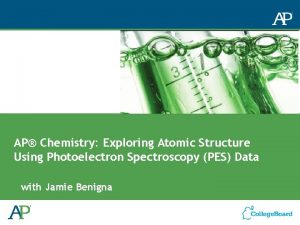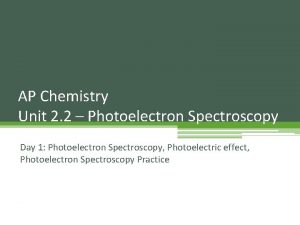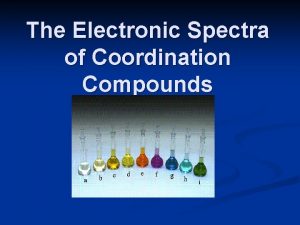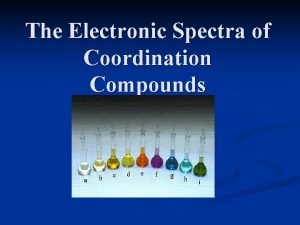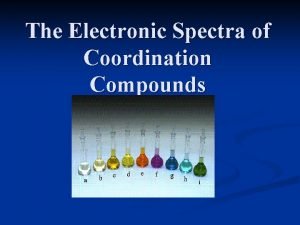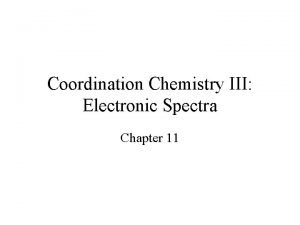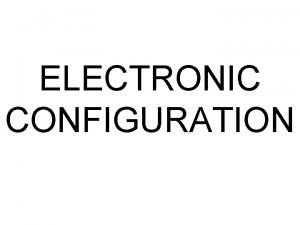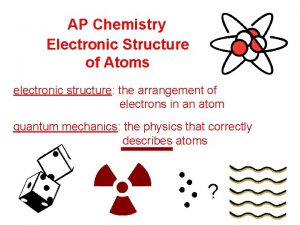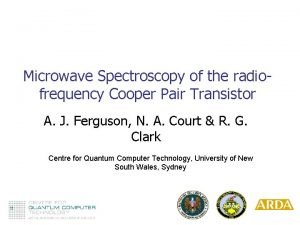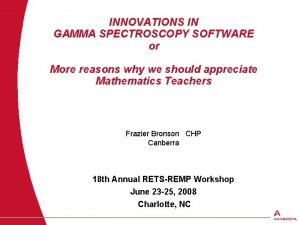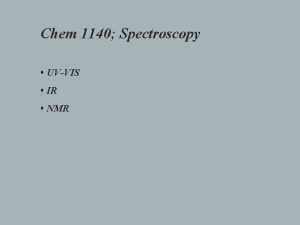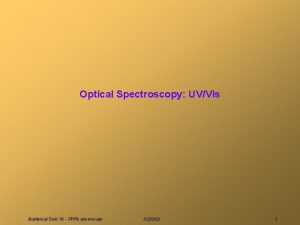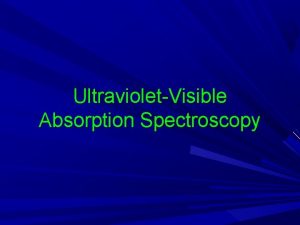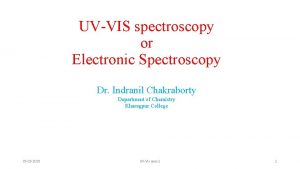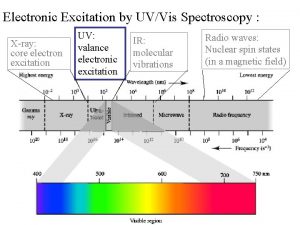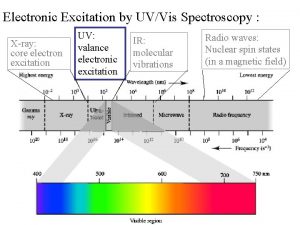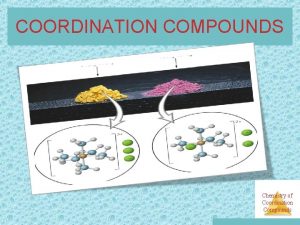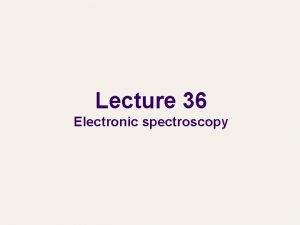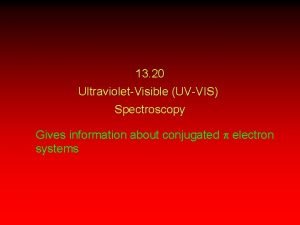Coordination Chemistry Electronic Spectroscopy UVVis 1 1 Electronic


![A. The Spectrochemical Series I- < Br - < [NCS]- < Cl- < F- A. The Spectrochemical Series I- < Br - < [NCS]- < Cl- < F-](https://slidetodoc.com/presentation_image_h2/519838e5ad892d9eb395def23627e0ee/image-3.jpg)


![Cobalt (III) Octahedral Complexes; 6 d I- < Br - < [NCS]- < Cl- Cobalt (III) Octahedral Complexes; 6 d I- < Br - < [NCS]- < Cl-](https://slidetodoc.com/presentation_image_h2/519838e5ad892d9eb395def23627e0ee/image-6.jpg)

![I. Spin forbidden d-d e transitions [Mn(H 2 O)6]2+ is high-spin d 5 Mn(II): I. Spin forbidden d-d e transitions [Mn(H 2 O)6]2+ is high-spin d 5 Mn(II):](https://slidetodoc.com/presentation_image_h2/519838e5ad892d9eb395def23627e0ee/image-8.jpg)








- Slides: 16

Coordination Chemistry: Electronic Spectroscopy (UV-Vis) 1

1. Electronic spectroscopy pertaining to d-orbital e (Introduction) § Typically occur in the visible range of light. 2
![A The Spectrochemical Series I Br NCS Cl F A. The Spectrochemical Series I- < Br - < [NCS]- < Cl- < F-](https://slidetodoc.com/presentation_image_h2/519838e5ad892d9eb395def23627e0ee/image-3.jpg)
A. The Spectrochemical Series I- < Br - < [NCS]- < Cl- < F- < [OH]- < [ox]2 - ~ H 2 O < [NCS]- < NH 3 < en < [CN]- ~ CO § σ donor Weak field ligands § Small Δ § High spin § π donors Ligands increasing Δoct Strong field ligands § Large Δ § Low spin § π acceptors 3

Cobalt (III) Octahedral Complexes; 6 d Weak field vs Strong field extremities dictated by ligand coordination. eg E eg t 2 g Small Δoct Weak Field, High spin S=2 Δoct t 2 g Big Δoct Strong Field, Low spin S=0 4

d-d electronic transition and Δoct = E = hν = h c λ Δoct , λ 5
![Cobalt III Octahedral Complexes 6 d I Br NCS Cl Cobalt (III) Octahedral Complexes; 6 d I- < Br - < [NCS]- < Cl-](https://slidetodoc.com/presentation_image_h2/519838e5ad892d9eb395def23627e0ee/image-6.jpg)
Cobalt (III) Octahedral Complexes; 6 d I- < Br - < [NCS]- < Cl- < F- < [OH]- < [ox]2 - ~ H 2 O < [NCS]- < NH 3 < en < [CN]- ~ CO 3+ L = CN- L = NH 3 L = H 2 O 6

B. Electronic transition selection rules 1. Spin rule: Transitions must not involve a change of spin. § 2. ΔS = 0 Laporte rule: Transitions must have a change of parity. § Gerade Ungerade § No gerade nor ungerade § Technically all d-d electronic transitions are forbidden gerade ungerade 7
![I Spin forbidden dd e transitions MnH 2 O62 is highspin d 5 MnII I. Spin forbidden d-d e transitions [Mn(H 2 O)6]2+ is high-spin d 5 Mn(II):](https://slidetodoc.com/presentation_image_h2/519838e5ad892d9eb395def23627e0ee/image-8.jpg)
I. Spin forbidden d-d e transitions [Mn(H 2 O)6]2+ is high-spin d 5 Mn(II): eg t 2 g S = 2. 5 S = 1. 5 § Extremely weak transitions; ε < 1 M-1 cm-1 RECALL Beer’s Law: A = ε b c § ε is a property of the absorbance of a chemical species § A measure of the intensity of an electronic transition 8

II. Laporte forbidden d-d e transitions A. For ideal octahedral complexes, d-d e- transitions are spin-allowed but Laporte forbidden § Extremely weak transitions; ε = 10 - 200 M-1 cm-1 i. e. [Co(H 2 O)6]3+ is high-spin d 6 Co(III): eg t 2 g S=2 9

II. Laporte forbidden d-d e transitions B. For ideal tetrahedral complexes, d-d e- transitions are spin-allowed but “less” Laporte forbidden than octahedral complexes because they are non-centrosymmetric complexes. § ε = 100 – 1, 000 M-1 cm-1 i. e. [Ni(Cl)4]2 - is high-spin d 8 Ni(II): S=1 t 2 e e S=1 10

2. Charge transfer electronic transitions Charge transfer e- transitions are Spin and Laporte allowed; ε > 1, 000 M-1 cm-1 § Typically observed in the UV range of light A. Ligand to metal charge transfer (LMCT) e. L M § Transfer of an electron from an orbital with primarily ligand character to one with primarily metal character § Can be observed with π donor ligands B. Metal to ligand charge transfer (MLCT) e. M L § Transfer of an electron from an orbital with primarily metal character to one with primarily ligand character § Can be observed with π acceptor ligands 11

3. Solution preparations to observe e transitions 1. Concentrated solutions of coordination complexes need to be made to observe d-d e- transitions • m. M concentrations 2. Dilute solutions of coordination complexes need to be made to observe charge transfer e- transitions • μM concentrations 12

4. A closer look at d-d e transitions 1. Requires an extension of crystal field theory by treating the ligand field as not a purely electrostatic model § Ligand field theory 2. Must consider the atomic state of a multi-electron system and the allowed electronic transitions 3. Must consider transitions in weak field and strong field coordinations 13

1 d A absorbance Consider a d 1 electron configuration: i. e. [Ti(H 2 O)6]3+ Ti 3+ Electronic absorbance Ground State dxz dz 2 dx 2 – y 2 dyz dxy dxz dyz dxy 14

Simplified 2 d Orgel Diagram § To determine Δoct, need to approximate the value of the Racah parameter B § B accounts for electron-electron repulsions § A measure of the splitting of the initial atomic states 15

5 d Tanabe-Sugano Diagram § Weak field (high spin) - 6 A is the ground state 1 g - No spin-allowed transitions § Strong field (low spin) - 2 T is the ground state 2 g - Four allowed transitions 2 T 2 2 g to A 2 g or T 2 g to T 1 g 2 T 2 g to 2 Eg 2 T 2 g to 2 T 2 g (2 I) 2 T 2 g to 2 A 1 g - Four absorbances but due to resolution may not actually see them 16
 Site:slidetodoc.com
Site:slidetodoc.com Types of electronic transition in uv-visible spectroscopy
Types of electronic transition in uv-visible spectroscopy Photoelectron spectroscopy ap chemistry
Photoelectron spectroscopy ap chemistry Photoelectron spectrum of scandium
Photoelectron spectrum of scandium Electronic spectra of coordination compounds
Electronic spectra of coordination compounds Electronic spectra of coordination compounds
Electronic spectra of coordination compounds Correlation diagram in coordination chemistry
Correlation diagram in coordination chemistry Correlation diagram in coordination chemistry
Correlation diagram in coordination chemistry Coordination number
Coordination number An electronic is the electronic exchange of money or scrip
An electronic is the electronic exchange of money or scrip Electronic news gathering and electronic field production
Electronic news gathering and electronic field production Electronic configurations
Electronic configurations Ap chemistry electronic structure of atoms
Ap chemistry electronic structure of atoms Inorganic vs organic chemistry
Inorganic vs organic chemistry Ib organic chemistry functional groups
Ib organic chemistry functional groups Microwave spectroscopy definition
Microwave spectroscopy definition Ortec renaissance
Ortec renaissance


